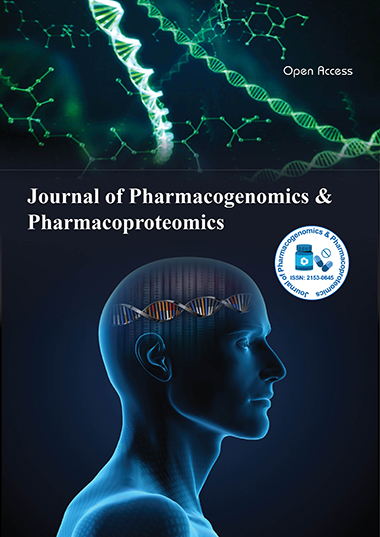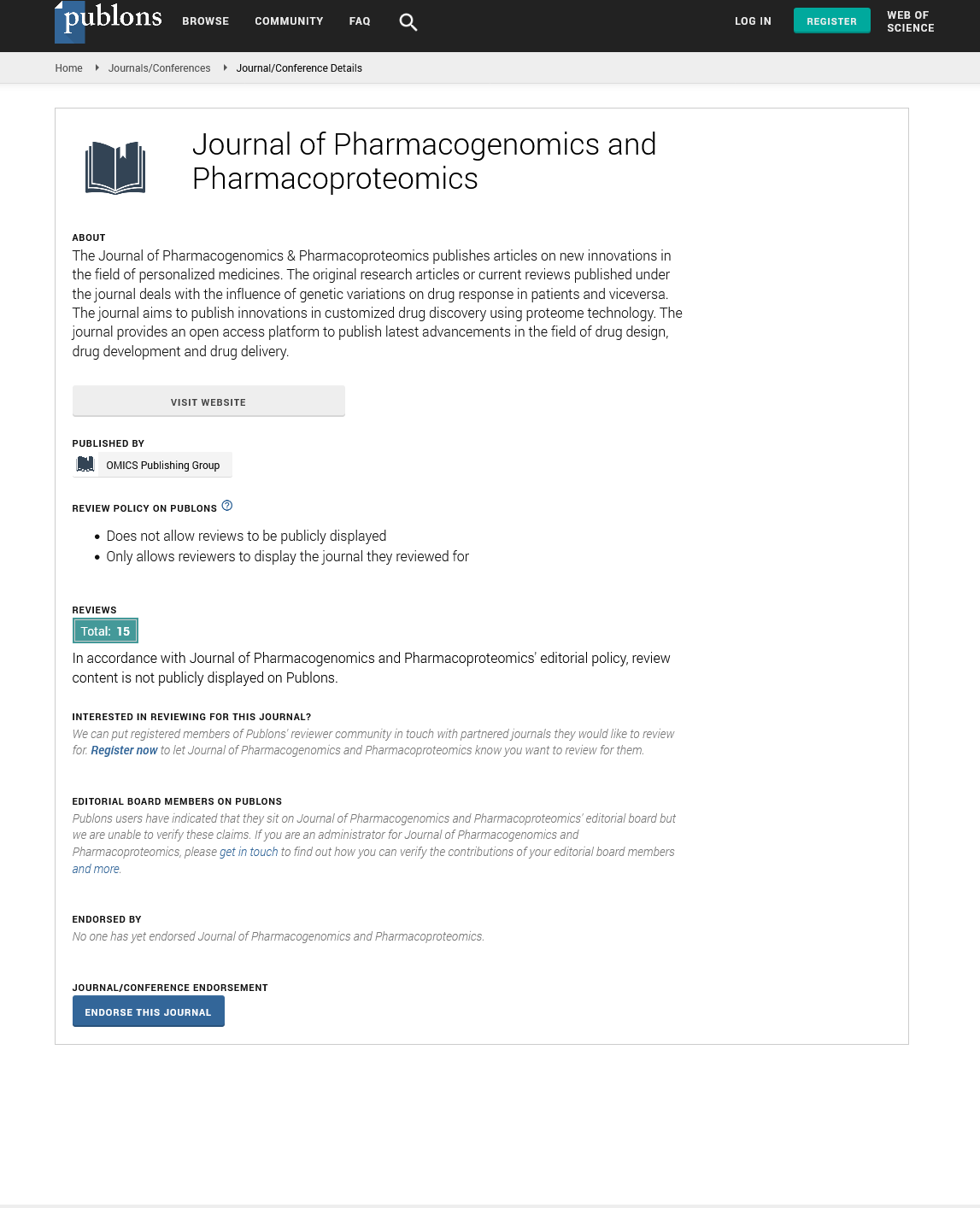Indexed In
- Open J Gate
- Genamics JournalSeek
- Academic Keys
- JournalTOCs
- ResearchBible
- Electronic Journals Library
- RefSeek
- Hamdard University
- EBSCO A-Z
- OCLC- WorldCat
- Proquest Summons
- SWB online catalog
- Virtual Library of Biology (vifabio)
- Publons
- MIAR
- Euro Pub
- Google Scholar
Useful Links
Share This Page
Journal Flyer

Open Access Journals
- Agri and Aquaculture
- Biochemistry
- Bioinformatics & Systems Biology
- Business & Management
- Chemistry
- Clinical Sciences
- Engineering
- Food & Nutrition
- General Science
- Genetics & Molecular Biology
- Immunology & Microbiology
- Medical Sciences
- Neuroscience & Psychology
- Nursing & Health Care
- Pharmaceutical Sciences
Short Communication - (2025) Volume 16, Issue 1
Genetic Polymorphisms in CYP2C9 and the Variability in Warfarin Response Among South Asian Populations
Nikhil Ramanathan*Received: 26-Feb-2025, Manuscript No. JPP-25-29325; Editor assigned: 28-Feb-2025, Pre QC No. JPP-25-29325(PQ); Reviewed: 14-Mar-2025, QC No. JPP-25-29325; Revised: 21-Mar-2025, Manuscript No. JPP-25-29325(R); Published: 28-Mar-2025, DOI: 10.4172/2153-0645.25.16.123
Description
Warfarin remains one of the most widely used oral anticoagulants for the prevention and treatment of thromboembolic disorders. However, its narrow therapeutic window and high interindividual variability necessitate careful dose titration and monitoring [1]. Pharmacogenomics has provided critical insights into the genetic underpinnings that influence warfarin metabolism, particularly variations in the cytochrome P450 2C9 (CYP2C9) and Vitamin K Epoxide Reductase Complex Subunit 1 (VKORC1) genes. Among various ethnic populations, South Asians exhibit a distinct allele frequency distribution that significantly affects drug response and dosing [2].
The CYP2C9 gene encodes an enzyme responsible for the metabolic clearance of the S-enantiomer of warfarin, which is three to five times more potent than the R-enantiomer. Allelic variants such as CYP2C9*2 and CYP2C9*3 have been associated with reduced enzymatic activity, resulting in slower warfarin clearance and a higher risk of bleeding. Studies among South Asian cohorts have shown a lower prevalence of CYP2C9*2 but a comparable or slightly elevated frequency of CYP2C9*3 in comparison to Caucasian populations [3]. This suggests that South Asians may be particularly vulnerable to adverse events due to delayed drug metabolism even at modest dosages.
Moreover, the VKORC1 gene polymorphisms, particularly the -1639G>A variant, have been identified as key determinants of warfarin sensitivity. This single nucleotide polymorphism leads to decreased VKORC1 expression and increased sensitivity to warfarin. In South Asian populations, the A allele is moderately frequent, suggesting that both VKORC1 and CYP2C9 polymorphisms should be considered when initiating therapy [4]. However, unlike East Asians where the A allele dominates, South Asians exhibit a more heterogeneous distribution, necessitating individualized genetic screening rather than relying on population averages [5].
The significance of incorporating pharmacogenomic testing prior to warfarin initiation in clinical practice has been reinforced by several prospective studies. One such study in Mumbai, involving 300 patients with atrial fibrillation, demonstrated that genotype-guided dosing resulted in a 40% reduction in hospitalization due to bleeding complications and a 25% faster time to achieve target INR compared to the conventional trial-and-error approach. These findings underscore the potential public health impact of routine pharmacogenomic profiling, especially in countries like India where genetic diversity is vast and infrastructure for regular INR monitoring may be limited [6].
Despite the capable implications, challenges remain in implementing widespread pharmacogenomic testing. These include high costs, limited availability of accredited laboratories and lack of awareness among healthcare providers. There is also a pressing need for population-specific dosing algorithms tailored to the South Asian genotype landscape. While international guidelines such as those from the Clinical Pharmacogenetics Implementation Consortium (CPIC) offer foundational recommendations, they often fall short in representing the genetic complexities of non-Western populations [7].
Efforts are underway to address these disparities. Multicenter collaborations across India, Pakistan and Bangladesh are currently evaluating region-specific warfarin pharmacogenomics panels. The objective is to integrate affordable genotyping assays with electronic medical records to create personalized dosing calculators. These tools are being piloted in tertiary care hospitals in Chennai and Lahore, with initial outcomes suggesting improved patient adherence and reduced adverse events [8].
The future of warfarin therapy in South Asia lies in the convergence of pharmacogenomics, health informatics and clinical pharmacology [9]. As the cost of genotyping continues to decline and awareness among physicians improves, it is plausible that routine testing for CYP2C9 and VKORC1 variants will become standard care. Furthermore, this model could serve as a prototype for other gene-drug pairs in anticoagulation, oncology and psychiatry, where interindividual variability has clinical consequences [10].
Conclusion
The presence of genetic polymorphisms in CYP2C9 and VKORC1 among South Asians underscores the need for pharmacogenomics-guided warfarin therapy. Precision medicine is not a Western luxury but a global imperative and its successful implementation in South Asia could dramatically improve outcomes in cardiovascular medicine. Bridging the gap between bench and bedside requires not only robust scientific evidence but also strategic policy changes and education for clinicians.
References
- Dargon PT, Landry GJ. Buerger’s disease. Ann Vasc Surg. 2012;26(6):871-880.
[Crossref] [Google Scholar] [Pubmed]
- Wigley FM. Raynaud's phenomenon. N Engl J Med. 2002;347(13):1001-1008.
- Dumoulin CL, Hart Jr HR. Magnetic resonance angiography. Radiology. 1986;161(3):717-720.
- Khatri P, Wechsler LR, Broderick JP. Intracranial hemorrhage associated with revascularization therapies. Stroke. 2007;38(2):431-440.
[Crossref] [Google Scholar] [Pubmed]
- Vane JR, Botting RM. Mechanism of action of nonsteroidal anti-inflammatory drugs. Am J Med. 1998;104(3S1):2S-8S.
- Akbari H, Pomerantz M, Taha H. Cool surfaces and shade trees to reduce energy use and improve air quality in urban areas. Sol Energy. 2001;70(3):295-310.
[Crossref] [Google Scholar] [PubMed]
- Hafeez A, Husain MA, Singh SP, Chauhan A, Khan MT, Kumar N, et al. Implementation of drone technology for farm monitoring & pesticide spraying: A review. IPA. 2023;10(2):192-203.
[Crossref] [Google Scholar] [Pubmed]
- Zhou Z, Siddiquee MMR, Tajbakhsh N, Liang J. Unet++: A nested u-net architecture for medical image segmentation. InDeep learning in medical image analysis and multimodal learning for clinical decision support: 4th international workshop, DLMIA 2018, and 8th international workshop, ML-CDS 2018, held in conjunction with MICCAI 2018, Granada, Spain, September 20, 2018, proceedings 4 2018 (pp. 3-11). Springer International Publishing.
- Chen LC, Papandreou G, Schroff F, Adam H. Rethinking Atrous convolution for semantic image segmentation.
- Rezatofighi H, Tsoi N, Gwak J, Sadeghian A, Reid I, Savarese S. Generalized intersection over union: A metric and a loss for bounding box regression. Proc IEEE Comput Soc Conf Comput Vis Pattern Recognit. 2019: 658-666.
Citation: Ramanathan N (2025) Genetic Polymorphisms in CYP2C9 and the Variability in Warfarin Response Among South Asian Populations. J Pharmacogenom Pharmacoproteomics.16:123.
Copyright: ©2025 Ramanathan N. This is an open-access article distributed under the terms of the Creative Commons Attribution License, which permits unrestricted use, distribution and reproduction in any medium, provided the original author and source are credited

